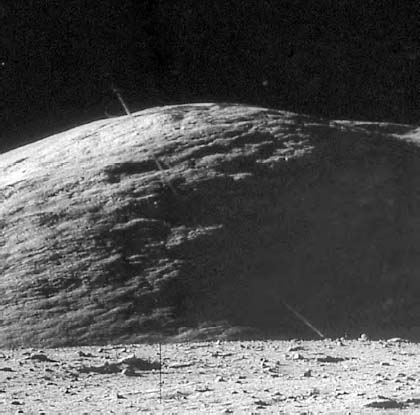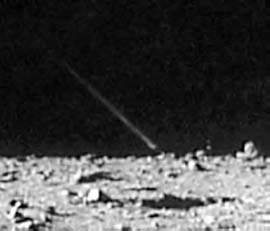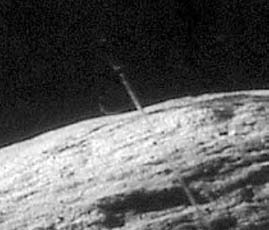Ancient Aliens on the Moon (26 page)
Read Ancient Aliens on the Moon Online
Authors: Mike Bara

TV image of “condos” built into the side of Mons Vitruvius miles beyond the camera location.
At first, AS17-134-20391 doesn’t seem very interesting or controversial. A hand-held Hasselblad shot taken by astronaut Gene Cernan, it shows the view out of the moving Lunar Rover as the astronauts made their way to geology station 1. The mountains in the background are Bear Mountain and part of the East Massif. Again, this all appears fairly unremarkable until you zoom up close onto the base of the East Massif and see… condos.
In sharpening and enhancing the “mountain,” you can plainly see rows and layers of evenly spaced, cell-like structures all along the front face of the East Massif. They appear to be built right into the face of the mountain, one row atop the other, exactly like something that once resembled a step pyramid. These room sized cells are unmistakable signs of artificial construction, resembling numerous such structures in the American Southwest, similar to the abandoned Anasazi ruins.

AS17-136-20767 and the Spar.
Confirmation of this rectangular pattern was later found on high definition broadcasts of EVA-1 shown on NASA TV. Taken by the color TV cameras on board the Rover after it had come to a stop at geology station 1, they confirm the same anomalous geometric pattern can be seen on two different kinds of cameras and recording media.
It’s also clear from the EVA transcripts that astronauts saw these bizarre, geometric patterns on all the hills and mountains surrounding the Taurus-Littrow valley. During one of the technical debriefings, Schmitt tried somewhat desperately to downplay them:
“It was a puzzle, seeing apparent lineations on the slopes of mountains.” Schmitt said. “Some people, as I recall, did some simulations, building models, putting random roughness on the surface, and then dusting them and moving the light around, and they were able to create apparent lineations just with light position. Generally, I think, people don’t feel that they represent any underlying structure, it’s just an accident of dusting and lighting. The massifs do have layers in them, layers of debris, and I think the fact that you see what appear to be zones of blocks at the top is probably a layer of relatively hard material. But they really are gross layers.”

Close-up of the base of the spar showing it connected to an anchor point on the ground, miles from the Lunar Rover at the base of the East Massif.

Wide angle showing glass ruins over the East Massif.
Schmitt’s comments are really nothing more than a variation of the old “trick of light and shadow” argument NASA has used for decades to explain away obviously unexplainable structures on various photographs of the Moon and Mars. But it’s clear that Schmitt, a trained geologist, was trying to understand or explain how such features could be formed naturally rather than face the simpler explanation—they couldn’t have formed naturally. They were artificial.
Further proof in support of this model (and the lunar dome model) came in the form of images scanned and downloaded from an Italian web site (since extinct) that displayed high resolution scans of photos taken on EVA-1 at around the same time and location. Apparently procured from European versions of early generation NASA negatives, these photos painted a completely different picture of the Taurus-Littrow valley than the one NASA has sought to advance The for years.

The upper tip of the Spar.

Contrast enhanced panorama.
Taken by Jack Schmitt a few minutes after Cernan’s earlier photo of the East Massif and Mons Vitruvius, Schmitt’s photo points in the same general direction as Cernan’s and also shows the same geometric pattern on the face of the East Massif outcropping. Taken at geology station 1 near Steno crater, Schmitt’s photo AS17-136-20767 also shows something else; a piece of semi-transparent spar-like glass structure which has sagged and collapsed over the mountain.
I must make it very clear here, this obviously structural spar does not appear currently on any NASA versions of this frame. It appears only on the Italian version apparently procured from a European scientific archive. Because of this, some people have sought to downplay it as a scratch on the print or negative, but this can be discounted by several observations. First, if you notice the spar follows the geometry of the light on the Moon that day; brighter and more reflective in the areas where there is ample sunlight and nearly invisible in the darker shadowed areas of the photo. It also follows the contours of the East Massif itself and seems to be anchored to the ground by a thin connecting wire. “Scratches” simply do not follow the contours of terrain or the geometry of the lighting in a photograph. If it was a scratch and not actually on the surface of the Moon, it would be the same brightness along its entire length.

A hole punched in the glass structure over the Taurus-Littrow valley.
There is also the question of the photo itself, which is of much higher quality than many NASA scans available today. This is because most of the photos on official NASA sites are copies of copies of copies, many generations removed from the originals. These Italian images appear to be more akin to Ken Johnston’s first generation prints in quality and detail. This makes the “scratch” explanation even more unlikely.
As part of the research for
Dark Mission
, we subsequently assembled a number of other scanned images from the European archives and found that they showed a far different version of the area around the East Massif than could be gleaned from current official NASA imagery. Under contrast enhancement, instead of the dark, pitch black sky that would be expected was instead highly organized, geometric blanket of light above the East Massif. This three- dimensional grid of semi-transparent structure looked exactly as would be expected After eons of bombardment from meteors and other debris. On several of the frames not only can very dark, spar-like vertical struts be seen, but there are even obvious areas where meteors have punched holes through the protective glass domes over the area.
Clearly, the “spar” itself is one of these vertical supports which has fallen from the matrix of glass overhead and collapsed down on the East Massif below. A close up of the upper part of the spar shows it still loosely connected to this fuzzy background material overhead. It’s also clear from these other images that the overall structural matrix of the glass dome over Taurus-Littrow remains intact but clearly has seen better days.
Ultra close-ups of the three-dimensional matrix show that it has a wavy, layered quality to it that is entirely consistent with multi-layered glass meteor shield. There are also some fairly obvious points where huge impacts have punched holes in the glass medium.
Taken together, all of these anomalies and structures make a very strong case for the presence of an ancient alien base in the Taurus-Littrow valley. From the odd room-like structures built into the East Massif to the Spar sagging on top of it to the massive glass matrix suspended over it, it is clear NASA had high motivation to take the risks associated with landing there. But this still was only EVA-1. What the astronauts found and did the next day, on EVA-2, would be even more extraordinary.
The next day after their relatively short EVA to Steno crater, EVA-2 called for Cernan and Schmitt to head pretty directly for the South Massif and the odd depression named Nansen. After that, they were scheduled to visit locations on the Lincoln Scarp and then stop at Shorty Crater, one of the key targets for the mission.
In looking at the orbital images of the landing site, it becomes quite obvious why these locations (and EVA-3 ‘s planned visit to the “Sculptured Hills”) were so important to NASA. Enhancements of the Apollo landing site orbital images show the same rectangular, geometric patterns on the faces of virtually all the hills and mountains in the landing vicinity. But the South Massif was something even more special.
Photos of the landing site taken by the high resolution panoramic camera on the Command Module from Apollo 15 show the entire South Massif is criss-crossed with highly unusual geometric patterns, both on the visible face of the massif and in the hollowed-out interior. In fact, looking at these photos of the supposed “vent hole” on the South Massif, the whole thing looks very curious, as if it did not collapse in on itself so much as it exploded outward, from the inside.